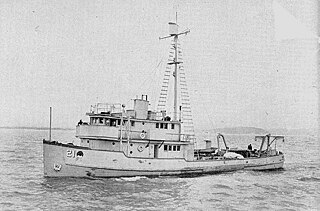USS Bunting (AMc-7) was a coastal minesweeper in the United States Navy. She was named after the bunting, a seed-eating bird intermediate in size between starlings and finches.
USS Hornbill (AMc-13) was a coastal minesweeper of the United States Navy, named after the hornbill.
USS Goshawk (AM-79), was a Goshawk class minesweeper built in 1919 as the steel-hulled fishing trawler M/V Penobscot by the Foundation (Marine) Co., Savannah, Georgia, for Mr. W. F. Henningsen, Seattle, Washington.
USS Pipit (AMc-1) was a Pipit-class coastal minesweeper acquired by the United States Navy for use in World War II. Her task was to clear minefields in coastal waterways.
USS Agile (AMc-111) was an Agile-class coastal minesweeper acquired by the United States Navy for the dangerous task of removing mines from minefields laid in the water to prevent ships from passing.

USS Affray (AMc-112) was an Acme-class minesweeper acquired by the U.S. Navy for the dangerous task of removing mines from minefields laid in the water to prevent ships from passing.
USS Radiant (AMc-99) was an Accentor-class coastal minesweeper acquired by the U.S. Navy for the dangerous task of removing mines from minefields laid in the water to prevent ships from passing.

USS Merit (AMc-90) was an Accentor-class coastal minesweeper acquired by the U.S. Navy for the dangerous task of removing mines from minefields laid in the water to prevent ships from passing.

USS Liberator (AMc-87) was an Accentor-class coastal minesweeper acquired by the U.S. Navy for the dangerous task of removing mines from minefields laid in the water to prevent ships from passing.
USS Ideal (AMc-85) was an Accentor-class coastal minesweeper acquired by the U.S. Navy for the dangerous task of removing mines from minefields laid in the water to prevent ships from passing.
USS Phoebe (AMc-57) was a coastal minesweeper acquired by the U.S. Navy for the dangerous task of removing mines from minefields laid in the water to prevent ships from passing.
USS Pintail (AMc-17) was a coastal minesweeper acquired by the U.S. Navy for the dangerous task of removing mines from minefields laid in the water to prevent ships from passing.
USS Nightingale (AMc-18) was a unique coastal minesweeper acquired by the U.S. Navy for the dangerous task of removing mines from minefields laid in the water to prevent ships from passing.

USS Nightingale was a YMS-1-class minesweeper of the YMS-135 subclass acquired by the U.S. Navy for the dangerous task of removing mines from minefields laid in the water to prevent ships from passing.

USS Killdeer (AMc-21) was a unique coastal minesweeper acquired by the U.S. Navy for the dangerous task of removing mines from minefields laid in the water to prevent ships from passing.

USS Road Runner (AMc-35) was a coastal minesweeper acquired by the U.S. Navy for the task of removing mines from minefields laid in the water to prevent ships from passing.
USS Barbet (AMc-38) was an Accentor-class coastal minesweeper acquired by the U.S. Navy for the dangerous task of removing mines from minefields laid in the water to prevent ships from passing.

USS Raeo (SP-588) was a United States Navy patrol vessel in commission from 1917 to 1919. Prior to her U.S. Navy service, she operated as the motor passenger vessel Raeo from 1908 to 1917. After the conclusion of her U.S. Navy career, she served as the fishery patrol vessel USFS Kittiwake in the United States Bureau of Fisheries fleet from 1919 to 1940 and as US FWS Kittiwake in the Fish and Wildlife Service fleet from 1940 to 1942 and from 1944 to at least 1945, and perhaps as late as 1948. During World War II, she again served in the U.S. Navy, this time as the yard patrol boat USS YP-199. She was the civilian fishing vessel Raeo from 1948 to 1957, then operated in various roles as Harbor Queen from 1957 to 1997. She became Entiat Princess in 1998 and as of 2009 was still in service.
Western Boat Building Company was a company based in Tacoma, Washington from 1916 until 1982. The company was founded by Martin Petrich, Joe M. Martinac and William Vickart. Within a few years, Joe Martinac left the partnership to go to the Tacoma Shipbuilding Company, and later started his own company. William Vickart was killed in an accident in 1921, leaving Martin Petrich the sole owner. In the early 1920s the company was located at the foot of Starr Street on part of the former Tacoma Mill Company property after that property was destroyed in a fire. Later yards were located on East 11th Street, D Street, and Marine View Drive. In 1937, the company built the Western Flyer as a purse seiner, and in 1940, this boat carried John Steinbeck on the journey which he documented in The Log from the Sea of Cortez. In 1949, the company launched the largest tuna clipper ever built up to that time, the 150-foot (46 m) Mary E. Petrich. Towards the end of World War II, the company founded its Fairliner division, which made high-speed boats. Before a devastating yard fire in 1950, the company was the largest builder of wooden pleasure boats on the United States West Coast. The company continued to build boats until 1982.

The USS YP-72 (ex-Cavalcade) was a converted fishing vessel which served as an auxiliary patrol boat in the U.S. Navy during World War II.






